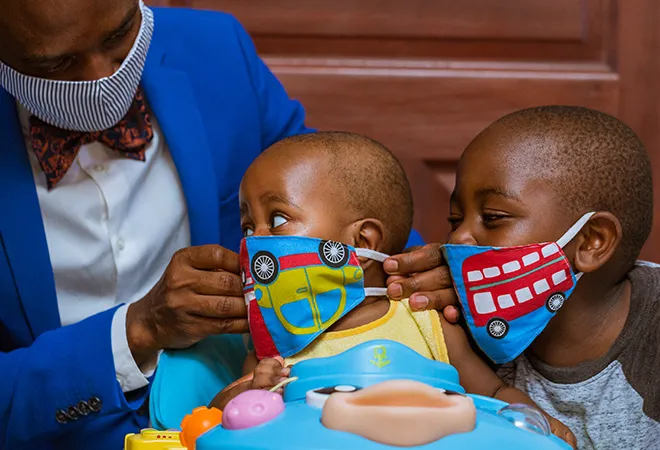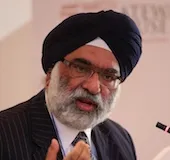
On 15 April 2020, G20 Finance Ministers took a decision to suspend the debt service payments for the world’s poorest economies in view of the Covid-19 pandemic. This would apply till the end of the year. This is expected to absolve these countries of debt servicing of nearly $20 billion and allow them to better face the impact of the pandemic. The plan asks all bilateral official creditors to join its efforts, while complying with their State laws and procedures. The G20 asked private creditors and multilateral development banks to also join this on comparable terms. India is the co-chair of the framework group that drew up key components of the plan.
The United Nations Economic Commission for Africa (UNECA) estimates a decline in export earnings of Africa by $65 billion this year. It also forecasts a fall in GDP growth rates to 1.8% from the earlier more robust expectation of 3.2%.
African countries are quite hopeful that the G20 countries and the multilateral development banks will comply and give their countries the necessary debt relief. Even as Africa may avoid the overwhelming pressure of the pandemic till now, its health infrastructure, internal migration and loss of critical export markets have attacked the basis of their economic stature. The fall in prices of oil and commodities has severely bitten into many economies in Africa. The pressure of exchange rates is also causing inflation and increasing the debt burden of US Dollar or Euro denominated borrowings.
ECA Executive Secretary Vera Songwe has said that “the continent would need up to $ 10.6 billion in unanticipated increases in health spending to curtail the virus from spreading, while on the other hand revenue losses could lead to unsustainable debt”. Remittances and tourism are reducing sharply; a decline in FDI flows, capital shifting out of Africa and a tightening of local financial markets besides the decrease in investments are all contributing to the economic downturn.
African governments are expected to revise their budget estimates and give priority to what is essential now in the face of these raucous economic activities. Dealing with food reserves to avoid famines is among them as well public health preparedness.
Another major focus of such exercise is the debt management and restructuring that most countries will need to undertake. Most loans are for infrastructure, education and health sectors but their repayments are due and need to be managed to avoid defaults and their consequences. Already South Africa has had to see the deprecation to junk status of its bonds.
From 2008-2018 Africa’s external debt increased by 150% according to the Quartz Africa weekly brief. The Ethiopian Prime Minister in an opinion piece in the New York Times, said debt repayments by the world’s lowest-income countries should be suspended until well after the coronavirus pandemic ends. In his view the scheme needs to be more ambitious and include debt cancellation and must include both official bilateral and commercial debt for low-income countries.
India is one of the major countries which increased its lending to Africa since 2004. Currently, about $9.7 billion in concessional lending over 100 LOCs are active in African countries. This is about 42% of the LOCs extended by India to all countries. By April 2020, EXIM Bank had signed 258 LOCs with 61 countries globally with credit aggregating $25.14 billion. With the exception of a few political issues in some countries, the record of repayment of African borrowers has been satisfactory. EXIM Bank in 2019 had signed new LOCs to rollover earlier LOCs for Central African Republic, rescheduling their debt till 2023-24. Earlier two LOCs were signed with Sudan for capitalization of unpaid interest since 2013.
Now, after the G20 plan for debt rescheduling, a window has been opened till 1 May during which countries may apply for rescheduling. This is not done automatically but on request. It is understood that some African countries like Comoros, Ethiopia, Zambia and Zimbabwe have applied for such debt rescheduling under which neither capital nor interest payments will be made till December 2020. Comoros has had one LOC for a power plant of about $40 million; Ethiopia has its earliest LOC for rural electrification of $65 million and the first tranche of the loans for the sugar factories for $122 million. Zambia’s earlier LOCs were for imports of vehicles and for equipment for the Itezhi Tezhi hydro project. Zimbabwe’s earlier LOCs were for a river water pumping project. Thus, India seems to be abiding by its G20 commitment but will go along with the consensus once the situation is assessed before December 2020. This approach by India needs to be welcomed.
Some of the lessons of the debt relief granted in the 1990s need to be recalled. At that time 31 African countries had received relief. Currently Africa owes $493.6 billion in long-term debt to foreign official and commercial creditors. About $117 billion is in the nature of tradable bonds. In 2019, most of these African countries budgeted more for debt servicing than on their health sectors. What happened earlier had happened again now with vulture funds swooping in and buying the commercial debts of countries like Ethiopia, DR Congo, Zambia and Uganda. Borrowers don’t have much say on these deeply discounted sales. They sought full repayment by these 15 countries at recent count, and sue those who resist. In case of Zambia, it paid $15.5 million to a vulture fund, which bought a debt for $3 million and sued Zambia for $55 million. This time, in order to better contribute to the well-being of African countries, the commercial debt would also have to be much better-monitored and dealt with since it’s already mentioned in the G20 communiqué. The idea of an Africa Brady plan, where the commercial debt will be put into a basket perhaps backed by US treasury or European Central Bank bonds and new bonds issued to prevent the pillage of African governments at these critical times is under discussion. The AU/ECA discussions is on a SPV to pool swaps, underwritten by a high-grade multilateral lender (the IMF?) or central bank (ECB?) and use it to alter commercial debt into longer term debt, possibly with a five-year grace term and reduced coupons. Lenders will exchange less liquid paper with possible AAA grade debt that can be placed in larger baskets. This is meant to cover about $16.25 billion in commercial debt payments in 2020. The AU’s special envoy for the pandemic response, Ngozi Okonjo-Iweala, indicated that the proposed SPV might be supported by special drawing rights of more affluent members of the International Monetary Fund.
China is not directly involved in these commercial debts sales but is mentioned as using these non-sovereigns BRI related debt to grab assets in Africa in lieu of the loans. The Kenya Mombasa railway is for instance guaranteed against profits from the Mombasa port. China owns 20% of the African debt so its role will remain important. Rather than outright relief, postponement of loan payments, debt restructuring, and debt/equity swap are more likely in China’s game plan.
Since India is a major player in Africa it should step up its intellectual input into creating the SPV with the AU/ECA and perhaps have a fund listed in India as well. This way the role of Indian services and markets as well as institutionalisation could be brought into the engagement with Africa and need not be restricted only to the provision of concessional finance through LOCs whose time may have just passed. That calls for a wider discussion to focus more on FDI than loans and grants.
The views expressed above belong to the author(s). ORF research and analyses now available on Telegram! Click here to access our curated content — blogs, longforms and interviews.




 PREV
PREV


